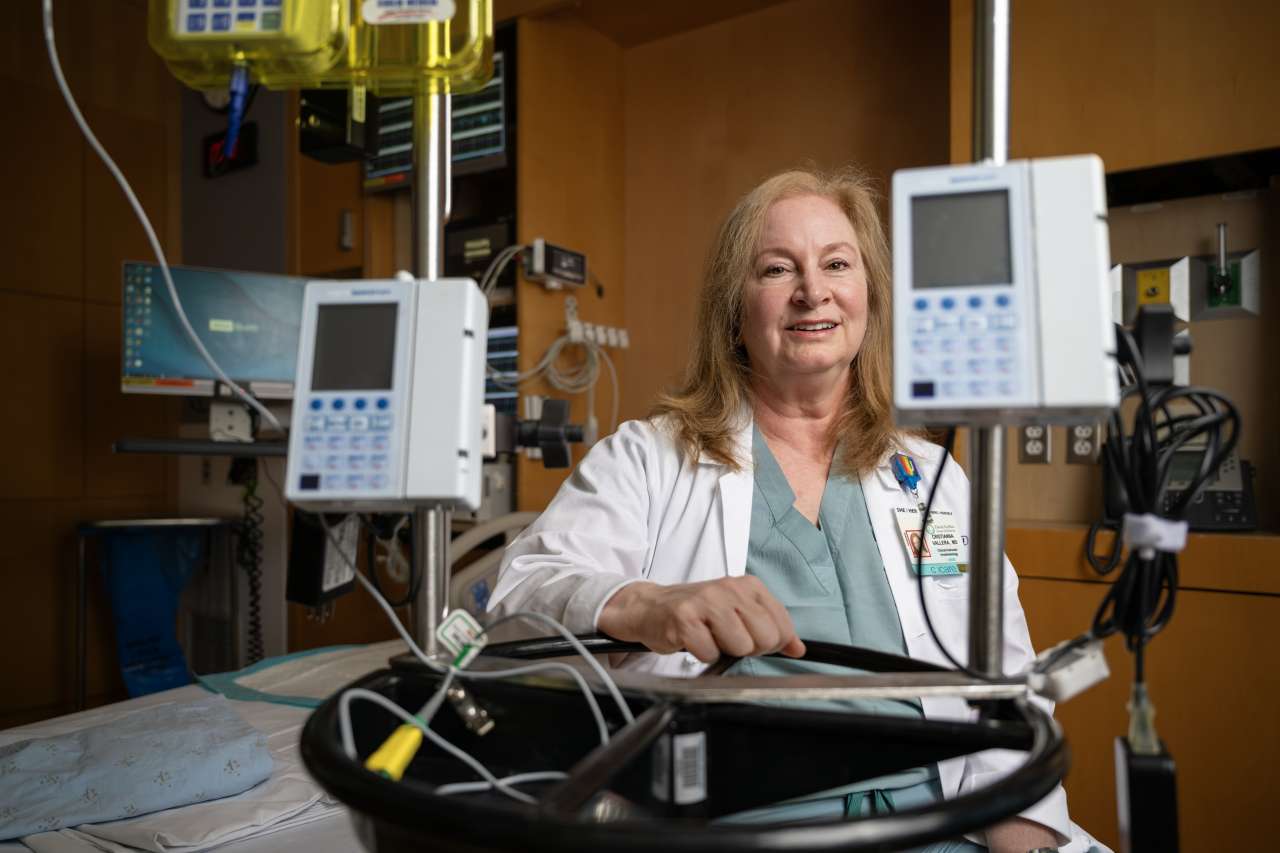Babies don’t always arrive on schedule. When the unexpected arises on a night or weekend, pregnant patients at Ronald Reagan UCLA Medical Center need immediate attention. And that, in turn, requires having a dedicated obstetric anesthesiologist on hand.
In an emergency situation, “we want to get the baby out as quickly and safely as possible,” said Cristianna Vallera, MD, an obstetric anesthesiologist. “And that requires being immediately available when the patient arrives.”
This level of staffing was one of several reasons UCLA Health’s Department of Anesthesia and Perioperative Medicine was recently named a Center of Excellence by the Society for Obstetric Anesthesia and Perinatology (SOAP). It’s a prestigious designation awarded to a select group of medical centers worldwide each year. Effective until 2029, it underscores UCLA Health’s expertise in caring for high-risk pregnant patients.
Emergency scenarios can occur at any time
In general, there’s less coverage in the hospital at night and on weekends, reflecting the reduced level of appointments and scheduled procedures. When it comes to obstetrics, while there may be patients arriving for scheduled labor inductions in the evening other routine procedures, such as Cesarean sections, aren’t scheduled at night, Dr. Vallera noted.
Instead, the obstetric anesthesiologists are on standby for situations that may require immediate action. One frequent scenario: a post-partum hemorrhage. It’s generally not life-threatening, but it can be if not treated promptly.
“Usually, when the placenta is delivered, the uterus starts to clamp down to get back to the size of a fist,” Dr. Vallera explained. However, if the uterus doesn’t contract, the resulting loss of blood requires immediate intervention. When this happens, the anesthesiologist will focus on getting immediate transfusion started and stabilizing the patient, Dr. Vallera said, allowing the surgeon to focus on treating the issue. Depending on the level of severity, there may be additional anesthesia needs to support emergency procedures such as manual extraction of the placenta, dilation and curettage (D&C), or even a hysterectomy as a last resort.
Or, there may be a patient who’s already been admitted and is in labor whose baby suddenly starts to show signs of distress. If the patient is brought to the operating room for a possible emergency C-section, “we also head to the OR in case we’re needed,” Dr. Vallera said. “A lot of times, the baby has recovered, but we're there to provide anesthesia if an emergency c-section is needed.”
And then there are the arriving urgent cases, such as a patient experiencing a dramatic, active breech birth.
In an emergency scenario, “the patient might urgently be taken to the OR shortly after arriving to the L&D (labor and delivery) floor,” Dr. Vallera said. “We’re focused on learning as much as we can about them, moving really quickly to start general anesthesia. It’s a very quick dance with us and the nurses and the surgeons.”
Ramping up dedicated staffing for high-risk patients
Dr. Vallera is one of 11 anesthesiologists with the Department of Anesthesia and Perioperative Medicine who have undergone additional training in high-risk obstetrics and provide the bulk of night and weekend care. There are 10 additional anesthesiologists who provide similar support, said Catherine Cha, MD, chief of obstetric anesthesiology, noting that they were selected after a rigorous application process. One of the 21 is always on hand nights and weekends to provide immediate care if needed.
Previously, Dr. Cha explained, the after-hours OB anesthesiologist would provide support in the operating room as well. As of 2024, however, the anesthesiologist on duty for obstetrics now focuses exclusively on obstetrics, rather than potentially needing to cover both areas. (Additional anesthesiology support for the OR has been expanded as well.)
Given the volume of deliveries at Ronald Reagan UCLA Medical Center, the additional anesthesiology coverage provides crucial support, including for high-risk patients.
“UCLA has one of the best maternal-fetal medicine teams in the country, which means an increase in high-risk patients,” Dr. Vallera said. “When we get patients whose lives have been challenged by pregnancy, we have the resources to take care of them.”
This includes caring for adult congenital cardiac maternity patients, for whom delivery is much riskier, she noted.

When patients are admitted but aren’t in the midst of a crisis situation, having a dedicated OB anesthesiologist allows the opportunity to establish a relationship with the patient, Dr. Vallera noted. “When patients are admitted, we’ll talk to them about their health history, whether they want an epidural, and what their goals are,” she said. “They can talk to us when they’re not in pain yet and can be active participants. We don’t do things to patients; we do things for patients.
“The unknown is scary,” she added. “Being able to go in and talk to them helps a lot.”
The feedback from obstetricians has also been extremely positive, Dr. Cha said. “Dedicated 24-hour coverage allows for increased presence of anesthesiologists on the Labor and Delivery floor,” she said, “enhancing everything from collaboration to patient experience.”
A bridge to the ICU
For Dr. Vallera, one night in particular stands out.
“I walked onto the floor about 5 p.m. and the daytime OB anesthesiologist was coming out of a patient’s room saying she needed an echocardiogram (an ultrasound examination of the heart). The patient had just arrived in labor, struggling to breathe. We had to tell her she had peripartum cardiomyopathy – heart failure. She was a runner, and there had been no warning signs.
“We pulled together the team and had her stabilized in the cardiothoracic ICU within an hour. We even called the surgeons in case she needed ECMO (external heart-lung support). She delivered the baby, and she survived. By then, it was the middle of the night. The baby started crying, and from the other end of the ICU you could hear people start cheering and clapping.”
Though this was an extreme case, the circumstances weren’t unique, Dr. Vallera said.
“We still get patients like that,” she said. “They thought everything was going smoothly, and then something unexpected happens.”
And when that happens, Dr. Vallera or one of her colleagues is there to help.





